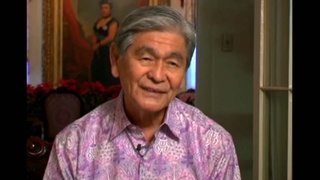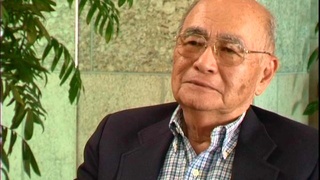Interviews
Education in a Buddhist temple and a country school
When I was 6 years old, my parents placed me in a Buddhist temple in Guadalupe, California, in a dormitory there so I could study the Japanese language, learn how to read and write and customs and the culture of Japan. After 6 years of shugyo -- shugyo is meditation, I guess you’d call it – we finally…all the children, 6 years old, you know, had to part with their parents. Very hard for them. They were crying every day, they wanted to go home. And finally after 6 years, they decided…parents decided to close the dormitory and all the children were able to go home.
So when I got back to my home, I was 12 years old and started to go to the country school not far from…we had to walk about a mile to go to this school and so mother would fix us a sandwich, you know. We’d eat the sandwich on the way and run, run, run to get there on time. The teacher there taught from the first grade through the eighth grade. He had just hailed in from New York City. He was a big tall man, you know, and every holiday he says…it was a potluck. All the parents would bring food like Thanksgiving, Halloween, Christmas. And after we ate, he says, “Everybody dance, even the 6-year-old.” That’s how I got started dancing. I enjoyed it so much. And his wife played the piano.
Date: December 6, 2005
Location: Oregon, US
Interviewer: Akemi Kikumura Yano
Contributed by: Watase Media Arts Center, Japanese American National Museum.
Explore More Videos

Teacher who helped with lisp
(b.1926) Democratic politician and three-term Governor of Hawai'i

Little interaction with parents
(1926 - 2012) Scholar and professor of anthropology. Leader in the establishment of ethnic studies as an academic discipline

Politics in ethnic studies
(1926 - 2012) Scholar and professor of anthropology. Leader in the establishment of ethnic studies as an academic discipline

Center for Japanese American Studies in community
(1926 - 2012) Scholar and professor of anthropology. Leader in the establishment of ethnic studies as an academic discipline

Involvement with ethnic studies
(1926 - 2012) Scholar and professor of anthropology. Leader in the establishment of ethnic studies as an academic discipline

Testing assumptions of Japanese scholars
(1926 - 2012) Scholar and professor of anthropology. Leader in the establishment of ethnic studies as an academic discipline

Kids working hard
An expert researcher and scholar on Japanese immigrant clothing.

First day of school
An expert researcher and scholar on Japanese immigrant clothing.

Grandmother's influence on decision to go to Japan
(b.1942) Japanese American ceramist, who has lived in Japan for over 30 years.

Training for football by carrying 100-lb bags of grass over mountains
(b.1925) Nisei of Okinawan descent. Had a 38-year career in Japan as a baseball player, coach, scout, and manager.

Teaching at the military language school during World War II
(b. 1924) Political scientist, educator, and administrator from Hawai`i

Lesson learned from community college faculty
(b. 1924) Political scientist, educator, and administrator from Hawai`i

Rewards of teaching
(b. 1924) Political scientist, educator, and administrator from Hawai`i

Japanese school
(b.1924) Japanese Canadian Nisei. Interpreter for British Army in Japan after WWII. Active in Japanese Canadian community

Strict school policy of separating boys and girls in Japan
(b.1920) Japanese Canadian Nisei. Established the Ikenobo Ikebana Society of Toronto
